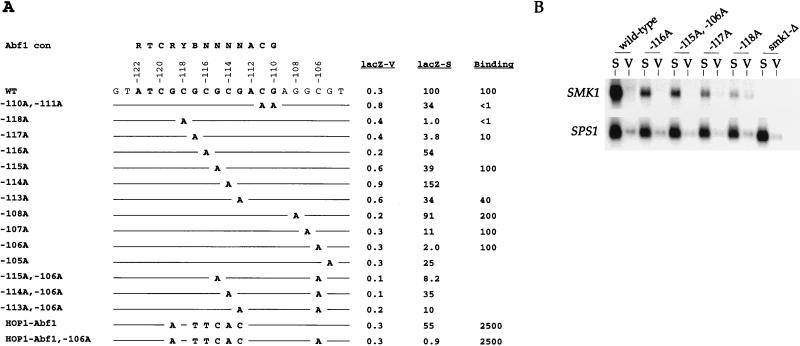FIG. 3.
Mutational analysis of UASS. (A) Effects of UASS mutations on expression of SMK1 and binding to Abf1p. Strains with the indicated mutations in the −124 promoter SMK1-lacZ plasmid pMDP126 were assayed for β-galactosidase activity in vegetative (V) and sporulated cultures at 10 h postinduction (S). β-Galactosidase activities are averages from at least two separate comparisons to the wild-type plasmid (pMDP126). Both vegetative and sporulation values are shown as percentages of the wild-type sporulation value (79 ± 8 U/mg of total protein). Relative complex formation between oligonucleotide duplexes containing the indicated mutation and partially purified Abf1p (Binding) was quantitated from a single titration curve performed as shown in Fig. 2. The mutations are referred to by the numbers at the left. Sequence requirements for Abf1p binding (Abf1 con) are shown above for comparison. The HOP1-Abf1 mutation contains a 6-bp substitution to generate the HOP1 Abf1p-binding site, which reads 5′-ATCACTTCACACG-3′. (B) Hybridization analysis of UASS promoter mutants. Indicated promoter mutations in the context of the wild-type SMK1 gene were integrated at the ura3 locus, and RNA was prepared from vegetative (V) or sporulated (S) cultures 10 h postinduction. Hybridization analysis was performed on total RNA by Northern blot analysis using an SMK1-specific probe. The same filter was subsequently hybridized with the middle sporulation SPO12-specific probe as a normalization control. The SMK1-specific hybridization signal in sporulating samples (normalized for SPO12 hybridization) was reduced to 51, 48, 23, and 17% of the wild-type signal in the −116A, −115A, −115A −106A, −117A, and −118A mutant strains, respectively.

